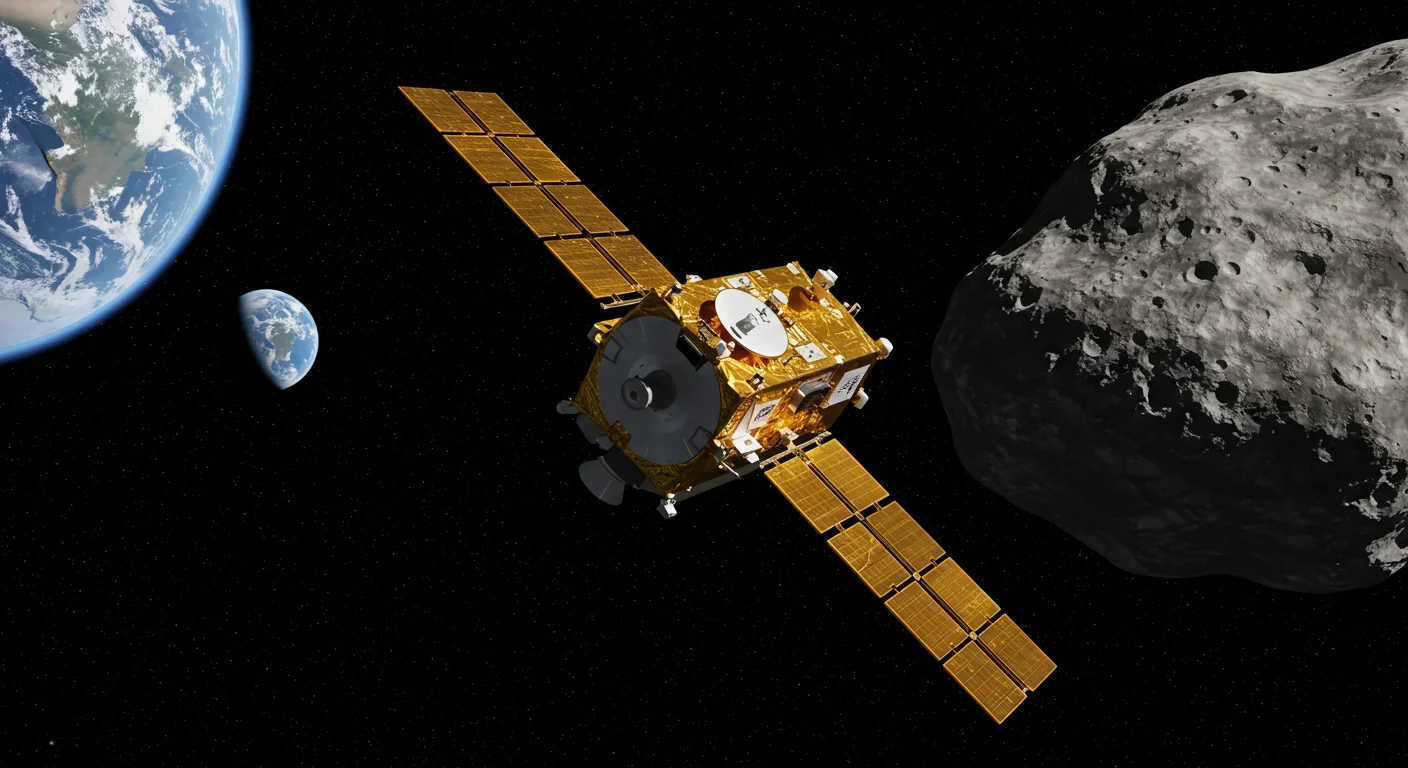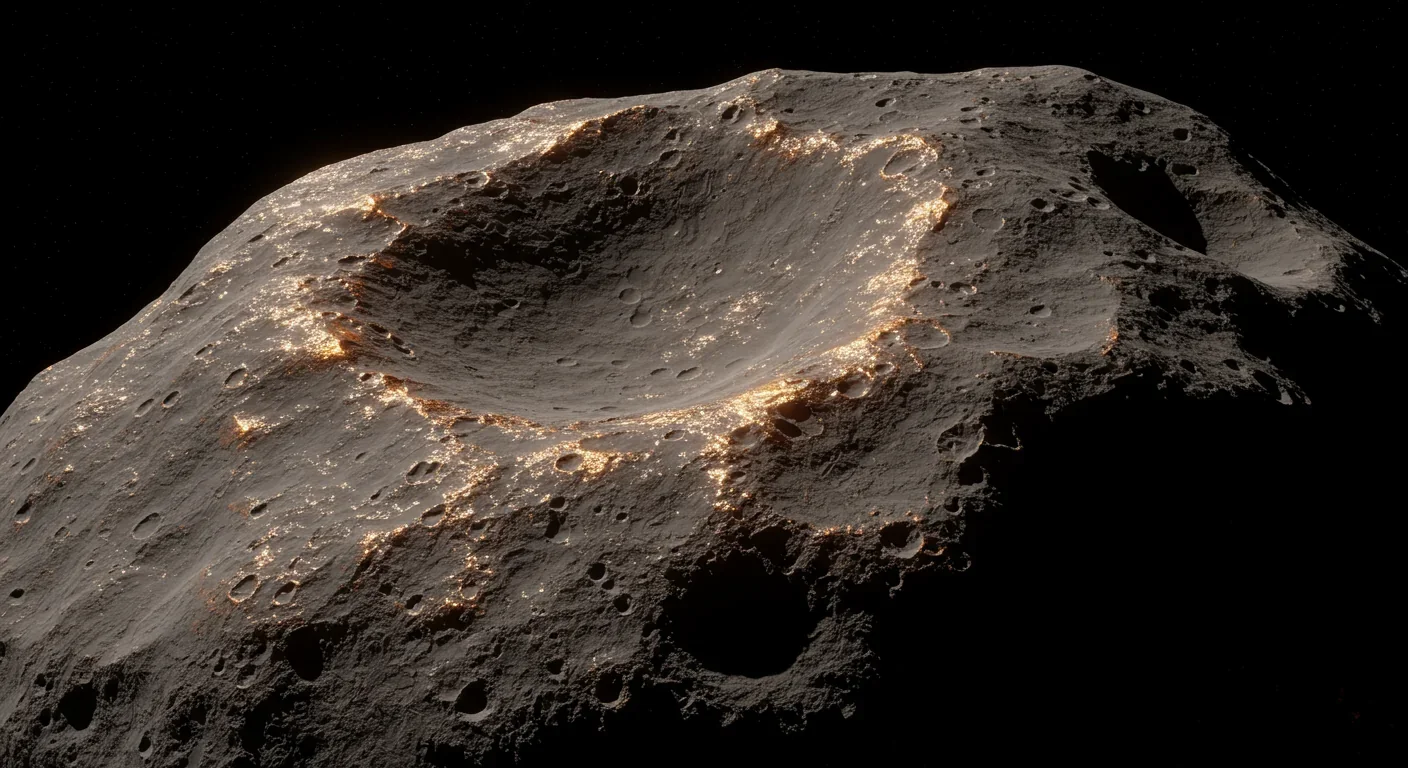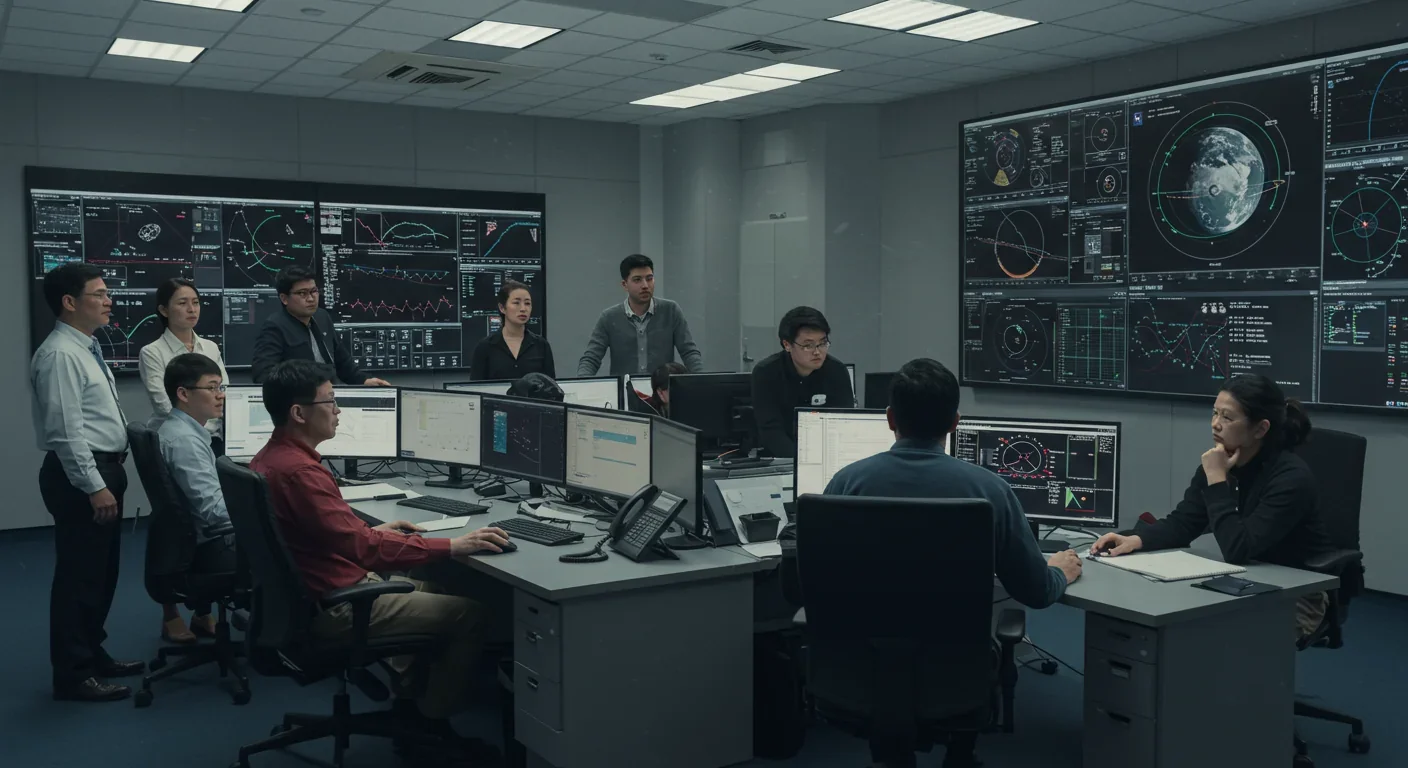The Gravity Heresy: MOND vs Dark Matter Theory Explained

TL;DR: NASA's Psyche mission, arriving in 2029, will study a metal-rich asteroid that may be an exposed planetary core. While headlines claim it's worth quintillions, the real value lies in understanding how planets form and advancing space resource technology.

In July 2029, a spacecraft will slip into orbit around one of the solar system's strangest objects. Not a rocky world, not an icy comet, but something rarer: a giant hunk of metal floating through space. NASA's Psyche mission, launched in October 2023, is headed to 16 Psyche, an asteroid that might be the exposed core of a failed planet. Headlines have breathlessly declared this 173-mile-wide object worth $10 quintillion, enough to make every person on Earth a billionaire. But those numbers miss the real story, which is far stranger and more important than any fantasy of cosmic wealth.
The Psyche spacecraft isn't chasing treasure. It's chasing answers to questions we can't study anywhere else. Deep inside Earth, beneath thousands of miles of rock, sits an iron-nickel core we'll never reach. The pressure down there would crush any drill, the heat would melt any probe. Yet understanding planetary cores is fundamental to knowing how rocky worlds form, how they generate magnetic fields, and ultimately, how they become habitable.
That's where 16 Psyche comes in. Scientists think this asteroid is a planetesimal's exposed core, a building block of a rocky planet that got blasted apart in the violent early solar system. When planets were still forming 4.5 billion years ago, countless collisions sent fragments spinning into space. Most asteroids are rubble piles or rocky debris, but Psyche appears to be something special: the stripped core of a world that never finished forming.
The spacecraft will spend roughly two years mapping Psyche's surface, measuring its gravity, hunting for magnetic fields, and determining exactly what it's made of. Three main instruments do the heavy lifting. A magnetometer will search for remnants of the ancient magnetic field that might have existed when this was a molten planetary core. A gamma-ray and neutron spectrometer will identify chemical elements on the surface. And a multispectral imager will photograph the terrain in visible and infrared light, revealing details about composition and structure.
What researchers find could rewrite our understanding of how planets differentiate, separating into distinct layers of core, mantle, and crust. Earth's magnetic field, generated by its churning liquid iron core, shields us from solar radiation and makes complex life possible. By studying Psyche, scientists hope to understand the magnetic dynamos that once operated inside small planetary bodies, and maybe still do on larger worlds.
Early observations suggested Psyche was almost pure metal, an iron-nickel sphere waiting to be mined. Reality turned out more complex. Radar observations and thermal studies now indicate metal comprises 30 to 60 percent of the asteroid's volume, with the rest likely silicate rock. That's still metal-rich by asteroid standards, where most bodies are predominantly rock or ice, but it's not the solid iron ball of early speculation.
The asteroid's bulk density of around 3.98 grams per cubic centimeter adds another puzzle. Pure iron has a density near 7.87 g/cm³, so if Psyche were solid metal, it would be far denser. The measured density suggests either a substantial rocky component or high porosity, meaning the asteroid might be riddled with voids and fractures. Some models propose Psyche could be as much as 50 percent empty space, a loosely consolidated rubble pile held together by gravity rather than a coherent metallic mass.
Surface features add more intrigue. Psyche's radar albedo, the fraction of radar signals it reflects back, varies dramatically across its surface from 0.22 to 0.52. Those are values two to four times higher than most main-belt asteroids, and the peaks correlate with optically bright patches. This suggests localized metal enrichment creates regions that are both highly reflective to radar and visually brighter, challenging assumptions about how metallic surfaces behave.
The asteroid's shape is irregular, roughly ellipsoidal at 278 by 238 by 171 kilometers. Its rotation period is just under five hours, fast enough to create a distinct equatorial bulge. That spin could complicate any future landing attempts, as the surface gravity, already less than one percent of Earth's, varies across the asteroid's lumpy profile.
Let's address the number that launched a thousand breathless headlines. If you took the estimated volume of metal in Psyche, multiplied by commodity prices for iron, nickel, platinum, and gold, you'd arrive at astronomical figures. Some calculations reached $10 quintillion, others $700 quintillion. These numbers are economically meaningless.
Commodity prices reflect scarcity. Flood the market with unlimited iron and nickel, and prices collapse. The entire global economy was valued at roughly $100 trillion in 2023. Adding 10,000 times that amount in raw materials wouldn't make anyone rich; it would obliterate the concept of monetary value for those materials. You can't harvest wealth that only exists because of scarcity and then expect it to retain value when scarcity disappears.
But the fixation on Psyche's "value" reveals something important about how we think about space resources. The real economic potential of asteroid mining isn't bringing metals back to Earth. It's using those resources in space. Building infrastructure in orbit, constructing spacecraft, establishing fuel depots - these activities become vastly cheaper if you don't have to haul every kilogram up from Earth's gravity well.
Launching material into low Earth orbit costs thousands of dollars per kilogram. Extracting it from a low-gravity asteroid, even factoring in the energy to reach that asteroid, could eventually cost far less. That's where the genuine economic transformation lies: not in asteroid gold bars on Earth, but in asteroid steel beams in space.
The technology to make this happen remains decades away. You'd need autonomous mining equipment that works in microgravity, processing facilities that can refine ore without water or air, and transport systems to move materials economically. None of these exist yet, though companies like Planetary Resources and Deep Space Industries have explored the concepts before scaling back ambitions.

Getting to Psyche tests the limits of current spacecraft capabilities. The asteroid orbits in the main belt between Mars and Jupiter, roughly three times farther from the Sun than Earth. That distance creates problems for traditional chemical rockets, which would require enormous fuel loads for the journey.
Instead, Psyche uses solar electric propulsion, a technology that converts sunlight into electricity to power ion engines. These engines produce tiny amounts of thrust, barely enough to feel if you held one in your hand on Earth, but they can operate continuously for months or years. The spacecraft accelerates gradually, eventually reaching speeds that chemical rockets can't sustain.
The journey includes a Mars flyby in 2026 for a gravity assist, using the planet's gravitational field to alter trajectory without burning fuel. This kind of orbital mechanics ballet requires precision calculations made years in advance. Miss the assist window by hours, and you could miss your target by millions of miles.
Communication lag poses another challenge. At Psyche's distance, radio signals take between 10 and 20 minutes to reach Earth, depending on orbital positions. That means the spacecraft must handle many operations autonomously, making decisions without waiting for ground control approval. The navigation system uses star trackers and inertial measurements to maintain orientation, but mapping an irregularly shaped, rotating asteroid demands sophisticated algorithms.
Mapping Psyche's gravity field will reveal how mass distributes inside the asteroid. If it's a homogeneous iron-nickel mass, gravity should be relatively uniform. If it's a fractured rubble pile with varying densities, gravity will show local variations. The spacecraft will orbit at different altitudes, measuring minute changes in its trajectory caused by Psyche's gravitational tugs.
Earth's magnetic field is generated by convection currents in its liquid outer core, a process called a geodynamo. As liquid iron circulates, driven by heat escaping from the inner core, it generates electrical currents that produce magnetic fields. This field extends tens of thousands of kilometers into space, deflecting the solar wind and charged particles that would otherwise strip away our atmosphere.
Smaller bodies like asteroids don't have active geodynamos today, their interiors long since cooled and solidified. But some did in the distant past. Meteorites from the asteroid Vesta show evidence of ancient magnetic fields, suggesting its core was once molten and convecting. If Psyche's magnetometer detects remnant magnetization in surface rocks, it would indicate this fragment also once had an active magnetic field.
Understanding these ancient dynamos helps explain why some planets retained thick atmospheres and magnetic protection while others, like Mars, lost theirs. Mars likely had a strong magnetic field billions of years ago when its core was still molten. As the planet cooled, the dynamo shut down, and solar wind gradually stripped away much of the atmosphere. Studying Psyche's magnetic history adds another data point to the story of how planetary magnetic fields evolve.
The gamma-ray and neutron spectrometer will map elemental composition by detecting radiation emitted when cosmic rays strike the surface. Different elements emit characteristic gamma-ray signatures. Iron emits specific energies, nickel others, and trace elements like sulfur, carbon, and oxygen each have unique signatures. This creates a chemical map showing not just where metal concentrates, but what other materials are present.
These measurements could reveal whether Psyche's formation involved melting and differentiation, like a true planetary core, or if it's simply metal-rich material that never fully melted. Temperature matters. A fully differentiated core forms when a planetesimal heats up enough for heavy metals to sink to the center and lighter rocks to float toward the surface. If Psyche shows layered composition, with pure metal at the center and mixed material toward the edges, it would support the planetary core hypothesis. If composition is roughly uniform, other formation scenarios become more likely.
The early solar system was a violent place. Planetesimals, ranging from a few kilometers to hundreds of kilometers across, collided constantly. Most merged to build planets, but countless others shattered. The asteroid belt preserves fragments from that era, a museum of planetary building blocks that never made it into finished worlds.
Most asteroids fall into categories based on composition. C-type asteroids are carbonaceous, primitive bodies rich in organic compounds and water. S-type asteroids are stony, composed mainly of silicate minerals and metals. M-type asteroids, like Psyche, show high radar reflectivity consistent with metallic composition. But M-types are rare, representing less than five percent of known asteroids.
Studying different asteroid types reveals the chemical diversity of the early solar system. Carbonaceous asteroids preserved volatile compounds that would have vaporized closer to the Sun, while metallic asteroids formed in hotter regions where silicates were less stable. The distribution of asteroid types through the belt traces temperature and chemical gradients in the protoplanetary disk.
Psyche's position, orbiting at 2.5 to 3.3 astronomical units from the Sun, places it in a zone where both rocky and metallic materials were stable. This might explain its mixed composition. If it formed as a differentiated planetesimal, violent collisions could have stripped away rocky mantle material, exposing metal-rich layers beneath while leaving some silicate debris mixed in.
Sample return missions to other asteroids have revolutionized planetary science. Japan's Hayabusa2 mission brought back material from asteroid Ryugu in 2020, revealing pristine samples of ancient solar system material. NASA's OSIRIS-REx returned samples from asteroid Bennu in 2023, providing organic compounds and minerals that predate Earth's formation. These missions showed what we can learn from direct analysis, but they targeted accessible near-Earth asteroids, not distant main-belt objects.
Psyche is too far and too massive for current sample-return technology, so scientists must extract maximum information from remote sensing. The mission's instrument suite was designed to answer specific questions about composition, structure, and history that don't require bringing rocks back to Earth labs.

While Psyche itself isn't a near-term mining target, understanding metallic asteroids informs future resource strategies. The asteroid belt contains vast amounts of material, but accessing it requires solving multiple engineering challenges: identifying the most resource-rich targets, developing extraction techniques that work in microgravity, creating processing methods that don't require Earth's atmosphere or water, and establishing economical transport.
Some near-Earth asteroids are more accessible than main-belt objects, requiring less energy to reach than the Moon. These could serve as early proving grounds for extraction technology. But most near-Earth asteroids are rubble piles or carbonaceous bodies, not the metal-rich targets that dominate science fiction scenarios.
Water ice, abundant in many asteroids, might be more valuable than metal in the near term. Water can be split into hydrogen and oxygen for rocket fuel, eliminating the need to launch propellant from Earth. Asteroid mining advocates often focus on water as the first economically viable resource, with metals coming later as industrial capacity in space grows.
The regulatory framework for space resource extraction remains undeveloped. The Outer Space Treaty of 1967 prohibits nations from claiming sovereignty over celestial bodies, but it's unclear how that applies to private companies extracting resources. The United States passed the Commercial Space Launch Competitiveness Act in 2015, asserting that American companies can own resources they extract from asteroids, but international consensus is lacking.
As more countries and companies develop space capabilities, these questions will shift from theoretical to urgent. The Psyche mission won't answer legal or economic questions, but it will provide the scientific foundation for understanding what resources actually exist on metallic asteroids and in what forms.
When Psyche reaches its target in August 2029, the real work begins. Initial orbits will be distant, hundreds of kilometers above the surface, allowing the spacecraft to characterize the asteroid's overall shape and rotation. As confidence in navigation grows, orbits will descend closer, eventually dropping to altitudes where surface features become visible in fine detail.
The mission timeline spans roughly 26 months in orbit, divided into phases with different objectives. Early phases focus on global mapping and composition surveys. Later phases target specific regions of interest with higher-resolution imaging and detailed spectroscopy. The lowest orbits will allow gravity field measurements that reveal internal structure.
Throughout the mission, data flows back to Earth at rates limited by distance and available power. The spacecraft's high-gain antenna transmits through NASA's Deep Space Network, which provides communication coverage for distant missions. Processing and analyzing the data will take years beyond the active mission phase, as researchers build models integrating observations from all instruments.
Success will be measured not in quintillions of dollars, but in scientific papers, refined planetary models, and new questions that emerge from unexpected findings. That's how space exploration works. We send robots to places we can't reach ourselves, ask them to look closely at things we've only glimpsed from afar, and discover that reality is richer and stranger than our predictions.
The Psyche mission reminds us why we explore space in the first place. Not to get rich quick, but to understand the universe we inhabit. That metal world spinning through the asteroid belt holds clues to how planets form their cores, generate magnetic fields, and create conditions for life. We're going there to read those clues. The story they tell will be worth far more than any pile of asteroid iron.

MOND proposes gravity changes at low accelerations, explaining galaxy rotation without dark matter. While it predicts thousands of galaxies correctly, it struggles with clusters and cosmology, keeping the dark matter debate alive.

Ultrafine pollution particles smaller than 100 nanometers can bypass the blood-brain barrier through the olfactory nerve and bloodstream, depositing in brain tissue where they trigger neuroinflammation linked to dementia and neurological disorders, yet remain completely unregulated by current air quality standards.

CAES stores excess renewable energy by compressing air in underground caverns, then releases it through turbines during peak demand. New advanced adiabatic systems achieve 70%+ efficiency, making this decades-old technology suddenly competitive for long-duration grid storage.

Our brains are hardwired to see patterns in randomness, causing the gambler's fallacy—the mistaken belief that past random events influence future probabilities. This cognitive bias costs people millions in casinos, investments, and daily decisions.

Forests operate as synchronized living systems with molecular clocks that coordinate metabolism from individual cells to entire ecosystems, creating rhythmic patterns that affect global carbon cycles and climate feedback loops.

Generation Z is the first cohort to come of age amid a polycrisis - interconnected global failures spanning climate, economy, democracy, and health. This cascading reality is fundamentally reshaping how young people think, plan their lives, and organize for change.

Zero-trust security eliminates implicit network trust by requiring continuous verification of every access request. Organizations are rapidly adopting this architecture to address cloud computing, remote work, and sophisticated threats that rendered perimeter defenses obsolete.